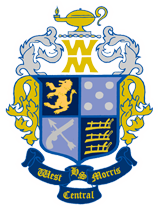From left, Team Ingenuity members Jeffrey Jiang, Matthew Lazorchak, Evan Pizzutillo, Jack Marchese and Marcellus Brown belong to one of two West VEX World Championships from Thursday, April 25 through Sunday, April 28 at the Kay Bailey Hutchinson Convention Center in Dallas, Texas.
Photo by Mark Kitchin
WASHINGTON TWP. – It’s not often that a high school can boast not only one but two teams going to a world championship event, but that’s what is happening at West Morris Central High School and its two robotics teams.
Team Legacy and Team Ingenuity qualified for two of New Jersey top eight spots in the VEX World Championships being held from Thursday, April 25 through Sunday, April 28 April 25-28 at the Kay Bailey Hutchison Convention Center in Dallas, Texas.
The teams qualified for the event following their performances in the State Tournament Final that was held in NJIT in Newark on Saturday, March 9. The nine members and their advisors are currently in the process of fundraising for the trip.
“We are extremely excited,’’ said sophomore Jay Tadinada. “It’s the first time our school has been able to go to worlds since the robotics club’s founding.’’
Team Legacy consists of seniors Conrad Chlipalski, Prenav Diddi, Noah Yacum and Ryan Taylor, junior Tadinada and freshman Dylan Curado..
Team Ingenuity boasts juniors Jeffrey Jiang, Matthew Lazorchak, Evan Pizzutillo, Jack Marchese. sophomore Marcellus Brown and Mendham High junior Kemi Folami.
The robotics teams are an after-school club open to students from both West Morris Central and West Morris Mendham high schools. Much like an athletic team, the students meet every day and spend long hours working on and perfecting their machines.
“It really is like sports in a way,’’ said West Morris Central teacher Justin Maier, who serves as an advisor along with teacher Rob Coiro. ”When you go to a competition it is like a sporting event. It’s crazy. Everyone is super dedicated. Everyone is super competitive. It is high energy.’’
VEX is a national organization that sponsors competitions worldwide. The group sets the rules and standards for the robots and each year creates a competitive game that pits teams with robots with and against each other in events. This year’s game was a type of soccer.
“They have weird-shaped balls, almost like an acorn shape and you have to score them under a goal,’’ Maier said. “There are a couple of different things you can do, to do that. You can catapult them from your side. They call it match loading where you introduce them into the field. The end game is you have to elevate your robot off the ground so your robot has to do multiple things in this game.’’
Members of the teams play different roles and are almost always asked to help out in different circumstances. Knowing how to code software is a must because the robots are put on autonomous programs during different parts of the game.
“Autonomous is 15 seconds at the start and during skills it is a minute,’’ Maier said. “For a minute you have to program the robot to score as many (points) as you can. That is what got these guys qualified. It is their programming skills.’’
Other duties include designing parts for the robot, building the robot and also driving the robot for the times it is not in autonomous mode. The robots are a work in progress over the course of the year as the early season competitions are used to improve and perfect the vehicles and their design.
“We went through three different design iterations across the whole year,’’ said Junior Jeff Jiang of their team Ingenuity machine. “We design everything digitally first before we do it physically. There are a lot of different design challenges. The competition changes across the time.’’
Early in the year, the focus was on defense and creating a large blocker to keep opponents from scoring but in the middle to the season, the team changed its philosophy entirely.
“We spent a lot of time designing the lift and it worked out fine but in time it turned out that speed was more important than height,’’ Jiang said. ”This was very bulky and not very maneuverable. That brings us into another iteration which we are doing now. This is very focused on speed and scoring and maneuverability and versatility, fulfilling any role that you need.’’
Journals
Not as showy but perhaps more important are the technical journals that the teams give the judges that provide in depth information about the robots and their design.
Evan Pizzutillo built and works in the pit crew for the Legacy robot but he’s quick to point out that Prenav Diddi is the Legacy team’s standout.
“He is our journaler,’’ Pizzutillo said. “You are looking at 400 pages to text. That is how detailed you have to be when you are submitting these journals for awards.
“Prenav is our glue. He holds the programmers, the builders, everyone together, so that issues don’t arise in the communications. The journals have to be submitted for each competition. You have to progressively build on them and they get extremely lengthy.’’
The robotics teams have been very visible in recent weeks. On Monday, Feb. 5, they put on a presentation for the West Morris Regional High School District to rave reviews.
During the recent Washington Township School District STEM (Science, Technology, Engineering and Math) Expo on Saturday, March 16, they commanded a large section of the gym, with plenty of room to show off the robots and give grade school kids a chance to run them on a practice playing field.
Winning awards in an international competition might be a lot to ask, but considering how far they have come, it’s not out of the question.
“This is a big deal for us.’’ Tadinada said.

